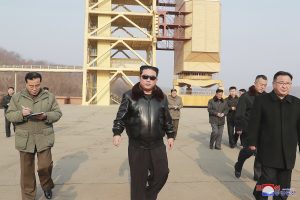The U.S. Department of Defense published a statement on Thursday with its analysis of two reconnaissance satellite tests conducted by North Korea on February 27 and March 5.
North Korea normally unveils the performances of its missiles a day after the tests, but it has not disclosed details of the two reconnaissance satellite tests, leading Washington and Seoul to closely look into the performance of the missiles and the possible rationale for the tests.
In a statement published by John Kirby, the press secretary of the Defense Department, the United States accused North Korea of testing its new intercontinental ballistic missile (ICBM) system through the reconnaissance satellite tests.
“Based on analysis of these launches, the United States Government has concluded that these launches involved a new Intercontinental Ballistic Missile (ICBM) system that the DPRK is developing, which was originally unveiled during the Korean Workers Party parade on October 10, 2020,” Kirby said in the statement. (DPRK is an abbreviation of North Korea’s formal name: Democratic People’s Republic of Korea)
The system unveiled during the military parade on October 2020, which was referred to in the statement, is a giant version of North Korea’s Hwasong-15 ICBM – known as Hwasong-17. As the North appears poised to test more larger missiles in the coming months, Washington is closely watching the possibility of the North deciding to test its ICBMs again.
North Korea tested its Hwasong-15 ICBM in November 2017. Since then, it has not conducted any ICBM or nuclear tests under leader Kim Jong Un’s self-imposed moratorium– which was made as a friendly gesture to encourage nuclear diplomacy with then-U.S. President Donald Trump. However, since the failed Hanoi Summit in 2019, North Korean official have repeatedly stated that the moratorium is no longer in effect, although Pyongyang has not yet explicitly broken it by testing ICBMs or nuclear devices. Washington now believes that the North could cross the red line anytime in the coming years.
In the first reconnaissance satellite test conducted on February 27, the North’s missile flew about 300 km at a maximum altitude of about 620 km. The missile that was test-fired on March 5 showed similar performance: 270 km range with 560 km apogee.
As United Nations Security Council resolutions ban North Korea from testing and developing any ballistic missiles, Washington and Seoul have condemned the North’s successive ballistic missile tests since January. However, Washington views the North’s so-called reconnaissance satellite tests as more serious, because satellite and ICBM launches require similar technology.
“The purpose of these tests, which did not demonstrate ICBM range, was likely to evaluate this new system before conducting a test at full range in the future, potentially disguised as a space launch,” Kirby’s statement reads.
The South Korean Defense Ministry also made similar remarks over the North’s reconnaissance tests, saying North Korea’s two most recent missile tests involved the regime’s new ICBM, the Hwasong-17.
While experts were predicting the North’s next moves in the lead up to the 110th birth anniversary of Kim Il Sung, the founder of the North and grandfather of the current leader Kim Jong Un, on April 15, North Korean state media reported on Friday that Kim Jong Un “gave field guidance to the Sohae Satellite Launching Ground.”
“He understood and estimated the present state of the Sohae Satellite Launching Ground and put forward tasks to rebuild it on a modern and expansion basis and build a number of new elements in the launching ground so as to launch the military reconnaissance satellite and other multi-purpose satellites by diverse carrier rockets in the future,” the state media reported.
Kim emphasized the importance of the Sohae Satellite Launching Ground as it is the place where the North launched two artificial earth satellites, Kwangmyongsong-3 and Kwangmyongsong-4, in 2012 and 2016 respectively. The North actually launched three artificial earth satellites, two in 2012, but the first one failed to reach orbit according to the North’s assessment at the time.
Kim also inspected the country’s National Aerospace Development Administration this week and said that his country will launch a lot of military reconnaissance satellites in coming years to provide real-time information on the military actions of the U.S. and its allies, according to the North’s state media.
Developing the country’s reconnaissance satellite capabilities is part of Kim’s five-year military modernization plan. North Korea is believed to still lack sufficient technology to secure high-quality, high-resolution images from space, considering its reports on the second satellite missile on March 5 did not include any images. South Korea’s Ministry of Defense had critiqued the low resolution of the images released following the February 27 launch.
As Kim has publicly kicked off his country’s race for more satellite launches, Washington and Seoul are going to coordinate more closely to cope with the possible scenario of the North launching ICBMs capable of reaching the U.S. mainland in the coming months.
































